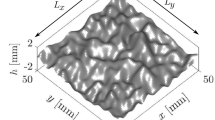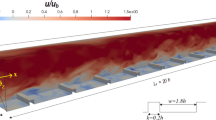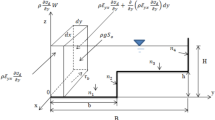Abstract
Two new experimental data sets for turbulent flow over a steep, rough hill are presented. These include detailed laser Doppler anemometry measurements obtained at the separation and reattachment points and, in particular, within the reverse flow region on the lee side of the hill. These results allow the development of a new parametrization for rough wall boundary layers and validate the use of Stratford’s solution for a separating rough flow. The experiments were conducted in a water channel for two different Reynolds numbers. In the first set of rough wall experiments, the flow conditions and the hill shape are similar to those presented in Loureiro et al. (Exp. Fluids, 42:441–457, 2007a) for a smooth surface, leading to a much reduced separation region. In the second set of experiments, the Reynolds number is raised ten times. The region of separated flow is then observed to increase, but still to a length shorter than that recorded by Loureiro et al. (Exp. Fluids, 42:441–457, 2007a). Detailed data on mean velocity and turbulent quantities are presented. To quantify the wall shear stress, global optimization algorithms are used. The merit function is defined in terms of a local solution that is shown to reduce to the classical law of the wall far away from a separation point and to the expression of Stratford at a separation point. The flow structure at the separation point is also discussed.




























Similar content being viewed by others
References
Allen B, Brown AR (2002) Large-eddy simulation of turbulent separated flow over rough hills. Bound Layer Meteorol 102:177–198
Andreopoulos J, Durst F, Zaric Z, Jovanovic J (1984) Influence of Reynolds number on characteristics of turbulent wall boundary layers. Exp Fluids 2:7–16
Arya SPS, Gadiyaram PS (1986) An experimental study of flow and dispersion in the wakes of three-dimensional low hills. Atmos Environ 20:729–740
Bandyopadhyay PR, Watson RD (1988) Structure of rough-wall turbulent boundary layer. Phys Fluids 31:1877–1883
Batchelor G, Proudman I (1954) The effect of rapid distortion of a fluid in turbulent motion. Q J Mech Appl Math 7:83-103
Britter RE, Hunt JCR, Richards KJ (1981) Air flow over a two-dimensional hill: studies of velocity speedup, roughness effects and turbulence. Q J R Meteorol Soc 107:91–110
Brown AR, Hobson JM, Wood N (2001) Large-eddy simulation of neutral turbulent flow over rough sinusoidal ridges. Bound Layer Meteorol 98:411–441
Bush WB, Fendell FE (1972) Asymptotic analysis of turbulent channel flow and boundary layer flow. J Fluid Mech 56:657–681
Castro IP (2007) Rough-wall boundary layers: mean flow universality. J Fluid Mech 585:469–485
Castro IP, Apsley DD (1997) Flow and dispersion over topography: a comparison between numerical and laboratory data for two-dimensional flows. Atmos Environ 31:839–850
Cruz DOA, Silva Freire AP (1998) On single limits and the asymptotic behaviour of separating turbulent boundary layers. Int J Heat Mass Transf 41:2097–2111
Daly JR, Harlow IH (1970) Transport equations in turbulence. Phys Fluids 13: 2634–2649
Durbin PA, Belcher SE (1992) Scaling of adverse-pressure-gradient turbulent boundary layers. J Fluid Mech 238: 699–722
Fernholz HH, Finley PJ (1996) The incompressible zero-pressure-gradient turbulent boundary layer: an assessment of the data. Prog Aero Sci 32:245–311
Flack KA, Schultz MP, Connely JS (2007) Examination of a critical roughness height for outer layer. Phys Fluids 19:95–104
Gad-el-Hak M, Bandyopadhyay PR (1994) Reynolds number effects in wall-bounded turbulent flows. Appl Mech Rev 47:307–365
Goldstein S (1948) On laminar boundary layer flow near a position of separation. Q J Mech Appl Maths 1:43–69
Hewer BJ (1998) Non-linear numerical model predictions of flow over an isolated hill of moderate slope. Bound Layer Meteorol 87:381–408
Hunt JCR, Leibovich S, Richards KJ (1988) Turbulent shear flow over low hills. Q J Roy Meteorol Soc 114:1435–1470
Iizuka S, Kondo H (2004) Performance of various sub-grid scale models in large-eddy simulations of turbulent flow over complex terrain. Atmos Environ 38:7083–7091
Ishihara T, Fujino Y, Hibi K (2001) Wind tunnel study of separated flow over a two-dimensional ridge and a circular hill. J Wind Eng 89:573–576
Jackson PS, Hunt JCR (1975) Turbulent wind flow over a low hill. Q J R Meteorol Soc 101:929–955
Kaimal JC, Finnigan JJ (1994) Atmospheric boundary layer flows. Oxford University Press, Oxford
Kim HG, Lee CM, Lim HC, Kyong NH (1997) An experimental and numerical study on the flow over two-dimensional hills. J Wind Eng Ind Aero 66:17–33
Krogstad PA, Antonia RA (1999) Surface roughness effects in turbulent boundary layers. Exp Fluids 27:450–460
Lighthill J (1986) An informal introduction to theoretical fluid mechanics, C.U.P
Loureiro JBR, Pinho FT, Silva Freire AP (2007a) Near wall characterization of the flow over a two-dimensional steep smooth hill. Exp Fluids 42:441–457
Loureiro JBR, Soares DV, Fontoura Rodrigues JLA, Pinho FT, Silva Freire AP (2007b) Water tank and numerical model studies of flow over steep smooth two-dimensional hills. Bound Layer Meteorol 122:343–365
Mellor GL (1966) The effects of pressure gradients on turbulent flow near a smooth wall. J Fluid Mech 24:255–274
Mellor GL (1972) The large Reynolds number, asymptotic theory of turbulent boundary layers. Int J Eng Sci 10:851–873
Na Y, Moin P (1998) Direct numerical simulation of a separated turbulent boundary layer. J Fluid Mech 374:379–405
Nakayama A, Koyama H (1984) A wall law for turbulent boundary layers in adverse pressure gradients. AIAA J 22:1386–1389
Perry AE, Joubert PN (1963) Rough-wall boundary layers in adverse pressure gradients. J Fluid Mech 17:193–211
Perry AE, Schofield WH, Joubert PN (1969) Rough-wall turbulent boundary layers. J Fluid Mech 37:383–413
Prandtl L (1925) Über die ausgebildete Turbulenz. ZAMM 5:136–139
Ross AN, Arnold S, Vosper SB, Mobbs SD, Nixon N, Robins AG (2004) A comparison of wind-tunnel experiments and numerical simulations of neutral and stratified flow over a hill. Bound Layer Meteorol 113:427–459
Simpson RL (1996) Aspects of turbulent boundary-layer separation. Prog Aero Sci 32:457–521
Snyder WH, Castro IP (2002) The critical Reynolds number for rough-wall boundary layers. J Wind Eng Ind Aerodyn 90:41–54
Stratford BS (1959) The prediction of separation of the turbulent boundary layer. J Fluid Mech 5:1–16
Sychev VV, Sychev Vik V (1980) On turbulent separation. USSR Comput Maths Math Phys 20:133–145
Sykes RI (1980) An asymptotic theory of incompressible turbulent boundary-layer flow over a small hump. J Fluid Mech 101:647–670
Townsend AA (1976) The structure of turbulent shear flow, C.U.P.
Wygnanski I, Fiedler HE (1970) The two-dimensional mixing region. J Fluid Mech 41:327–361
Yajnik KS (1970) Asymptotic theory of turbulent shear flow. J Fluid Mech 42:411–427
Ying R, Canuto VM (1997) Numerical simulation of the flow over two-dimensional hills using a second-order turbulence closure model. Bound Layer Meteorol 85:447–474
Acknowledgments
JBRL benefited from a Research Fellowship from the Brazilian Ministry of Science and Technology through Programme Prometro (Grant no. 554391/2006-6). ASM benefited from a Research Scholarship from the Brazilian National Research Council (CNPq). ASM is also thankful to the Rio de Janeiro Research Foundation (FAPERJ) (Grant no. E-26/171.198/2003) for the concession of further financial help regarding his stay at Oporto University. APSF is grateful to the Brazilian National Research Council (CNPq) for the award of a Research Fellowship (Grant no. 306977/2006-0). The work was financially supported by CNPq through Grants no. 477392/2006-7 and no. 476091-2007/1, and by the Rio de Janeiro Research Foundation (FAPERJ) through Grants E-26/171.346/2005 and E-26/171.198/2003. ASM, JBRL and FTP are grateful to Prof. Maria Fernanda Proença of the Hydraulics Laboratory of Oporto University for all her help in setting up the flow rig, as well as for some very interesting technical discussions.
Author information
Authors and Affiliations
Corresponding author
Rights and permissions
About this article
Cite this article
Loureiro, J.B.R., Monteiro, A.S., Pinho, F.T. et al. The effect of roughness on separating flow over two-dimensional hills. Exp Fluids 46, 577–596 (2009). https://doi.org/10.1007/s00348-008-0583-4
Received:
Revised:
Accepted:
Published:
Issue Date:
DOI: https://doi.org/10.1007/s00348-008-0583-4




